Our friend Wikipedia says...
The North Ronaldsay is a breed of sheep living on North Ronaldsay, the northernmost of the Orkney_Islands, Scotland. They are one survivor of a type of sheep formerly found across the islands of Orkney and Shetland (the other is the Shetland (sheep), belonging to the Northern European short-tailed sheep group of breeds.Eating seaweed, adapting to copper in their diet and drinking pond water must make fleece of the Ronaldsay sheep different in some way. Just by handling it, I found it difficult to feel or see the difference in wool from this particular breed of sheep on Orkney. But one thing I did find on Orkney was that retail stores generally stocked only the natural color of wool. It was obvious I had to buy some of the natural colored wool (posing below with marigold flowers).
They are notable for living almost entirely on seaweed for several months of the year, except for a short lambing season – this is the only forage available to them, as they are confined to the shoreline by a 6 feet dry-stone wall which encloses the whole island. The semi feral flock on North Ronaldsay is confined to the foreshore for most of the year to conserve the limited grazing inland.
The sheep have evolved a somewhat different physiology from other sheep, due to their unusual diet – their digestive system has adapted to extract the sugars in seaweeds more efficiently, and they have an increased susceptibility to toxicity to the trace element copper. he grazing habits of the sheep have also adapted to their peculiar diet: instead of grazing during the day and ruminating at night as other sheep generally do, the North Ronaldsays graze as the tide reveals the shore (twice in 24 hours), ruminating at high water. The sheep's source of fresh water is limited to the few freshwater lakes and ponds along the seashore.
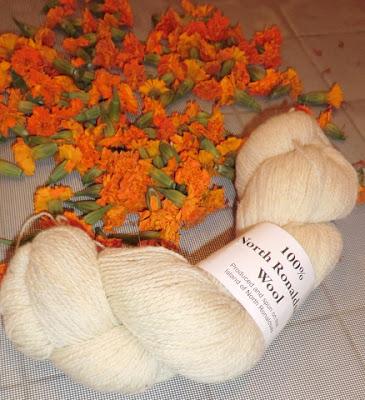 This 100% Ronaldsay wool (100 grams) is almost white. I was so happy to bring back natural colored wool and also some pretty dyed Ronaldsay wool, hand dyed by Pam Murray. You can find her here.
This 100% Ronaldsay wool (100 grams) is almost white. I was so happy to bring back natural colored wool and also some pretty dyed Ronaldsay wool, hand dyed by Pam Murray. You can find her here.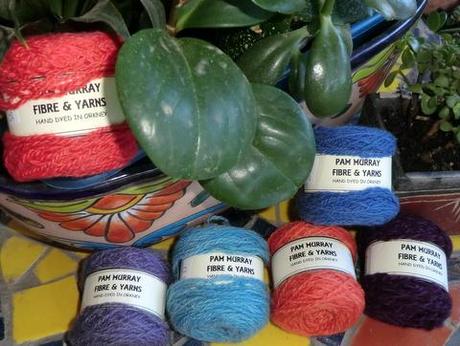 So now I have not only bits of colored Ronaldsay yarn from Pam Murray, but also some white.
So now I have not only bits of colored Ronaldsay yarn from Pam Murray, but also some white.But wait, there was no yellow or golden yellow or any other type of yellow Ronaldsay in the color palette.
So after I came home from Orkney, I decided to dyed some white Ronaldsay wool with marigolds to see what yellow hues came out of the natural flower petals.
Thank you, Polish Granddaughter, and Blue Castle Fiber Arts for good information on dyeing with natural dyes and mordants.
Remember that 100 + gram of natural wool? Here it is wound up and divvied it into four unequal amounts. The first two balls shown from left to right are the smaller amounts of wool that I used in dyeing for yellows; hopefully the first larger amount (1 oz.) will result in a darker yellow and the smaller ball (.6 oz) will result in a lighter shade of yellow.
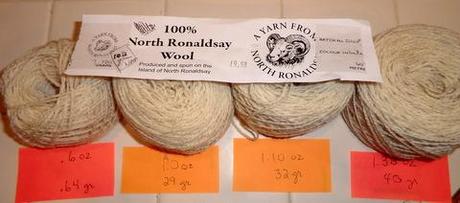
Here are the flowers, which were then slowly boiled for one hr.

The white wool, that one ounce shown above, was lightly skeined and tied at intervals to keep it together while being dyed. It had previously been submerged into hot vinegar water. That was the mordanting process (mordant: to assist in accepting color, meaning that the dye will "bite" into the fiber and hold on). Then it was submerged into the marigold tea and again simmered on the stove for another hour.
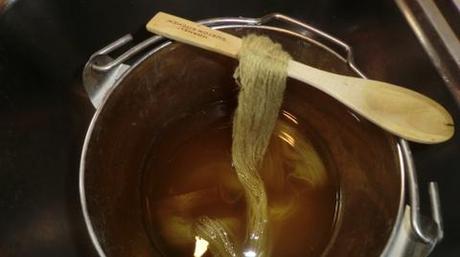
After soaking overnight, this ugly color resulted:
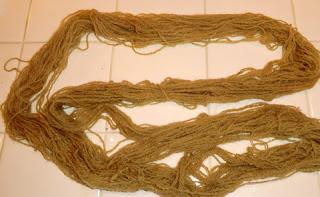 Kinda brown, kinda puke color. But I will NOT be defeated. Friend Natalie says I can have some of her marigolds. This time, I will go to the medical supply place and buy alum for the mordant instead of using vinegar. Then the process will begin again. Sigh. Hint to the wise: unlike what the internet told me, alum in not available at pharmacies. At least, not at the new Walgreen's in our fair city. The nice pharmacist said it was not used anymore (for what purposes it is used beyond dying is beyond me), so Walgreen's does not stock alum.
Kinda brown, kinda puke color. But I will NOT be defeated. Friend Natalie says I can have some of her marigolds. This time, I will go to the medical supply place and buy alum for the mordant instead of using vinegar. Then the process will begin again. Sigh. Hint to the wise: unlike what the internet told me, alum in not available at pharmacies. At least, not at the new Walgreen's in our fair city. The nice pharmacist said it was not used anymore (for what purposes it is used beyond dying is beyond me), so Walgreen's does not stock alum.Stay tuned for more of "AS THE WOOL TURNS COLOR", maybe tomorrow?
Linking with Tami at Works in Progress Wednesday. Go visit some other people who can actually SHOW you something pretty!
